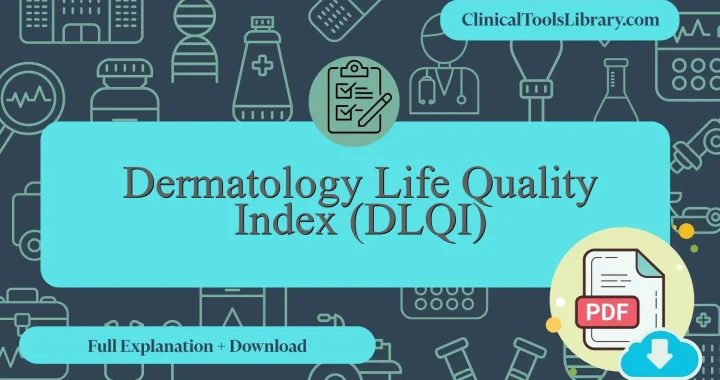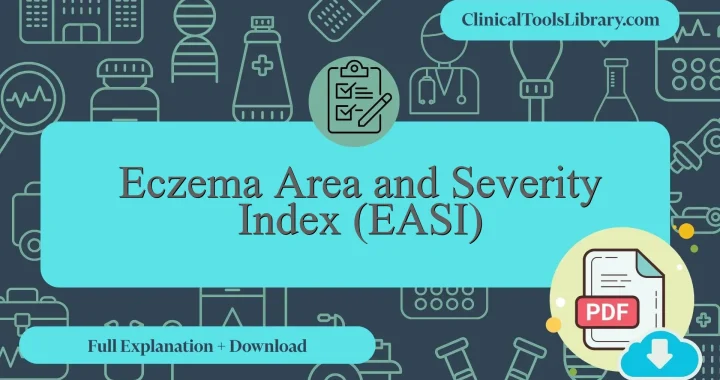In this article, we explain everything you need to know about the Dermatology Life Quality Index (DLQI). We will cover the aspects it evaluates, the target population, a detailed step-by-step explanation, and how to interpret its results. Additionally, we will dive into the scientific evidence supporting this tool (diagnostic sensitivity and specificity) in clinical assessment. You will also find official and unofficial sources available for download in PDF format.
What does the Dermatology Life Quality Index (DLQI) assess?
The Dermatology Life Quality Index (DLQI) is a validated tool designed to assess the impact of skin diseases on a patient’s quality of life. The dermatology life quality index (DLQI) questionnaire evaluates various dimensions including symptoms, feelings, daily activities, leisure, work or school, personal relationships, and treatment effects. Its main purpose is to quantify the burden of dermatological conditions, such as psoriasis, enabling clinicians to better understand the psychosocial implications of the disease. The DLQI score interpretation assists healthcare professionals in tailoring management plans and monitoring treatment outcomes. Tools like the Dermatology Life Quality Index calculator facilitate precise scoring, while specialized versions like the Children’s Dermatology Life Quality Index address pediatric populations. This instrument is recognized as a simple, practical measure for routine clinical use, enhancing patient-centered care in dermatology.
For which type of patients or populations is the Dermatology Life Quality Index (DLQI) intended?
The Dermatology Life Quality Index (DLQI) is primarily indicated for patients with chronic dermatological conditions such as psoriasis, eczema, and urticaria, where skin symptoms significantly impact daily functioning and psychological well-being. It is most useful in routine clinical settings as a practical tool for quantifying disease burden, facilitating treatment decisions, and monitoring therapeutic outcomes. The Dermatology Life Quality Index questionnaire provides a standardized method for assessing health-related quality of life, allowing clinicians to interpret the DLQI score objectively. Pediatric adaptations like the Children’s Dermatology Life Quality Index extend its applicability to younger populations with dermatologic diseases. Utilization of a Dermatology Life Quality Index calculator or form enables efficient integration into clinical workflows, supporting patient-centered care by highlighting the severity of impact beyond clinical signs.
Step-by-Step Explanation of the Dermatology Life Quality Index (DLQI)
The Dermatology Life Quality Index (DLQI) consists of 10 items designed to assess the impact of skin diseases on a patient’s quality of life. Each question addresses different domains such as symptoms and feelings, daily activities, leisure, work or school, personal relationships, and treatment. Patients respond using a four-point scale: “Not at all” (0), “A little” (1), “A lot” (2), and “Very much” (3). The clinician instructs the patient to consider the previous week when answering and ensures clarity on each item’s relevance. The total score ranges from 0 to 30, with higher scores indicating greater impairment. This structured approach allows for standardized evaluation of conditions such as psoriasis, eczema, and other dermatological disorders impacting daily functioning.
Dermatology Life Quality Index (DLQI) PDF: Download Original & English Questionnaires
Downloadable resources are available below, offering both the original and English versions of the Dermatology Life Quality Index (DLQI) questionnaire in PDF format. These forms are essential tools for assessing the impact of dermatological conditions such as psoriasis on patients’ quality of life. Clinicians can utilize these PDFs alongside the Dermatology Life Quality Index score and DLQI score interpretation guidelines to ensure accurate and consistent evaluation during routine clinical practice.
How to interpret the results of the Dermatology Life Quality Index (DLQI)?
The Dermatology Life Quality Index (DLQI) is a validated tool that quantifies the impact of skin diseases on a patient’s quality of life, with scores ranging from 0 to 30. Interpretation follows specific reference ranges: 0–1 indicates no effect, 2–5 a small effect, 6–10 a moderate effect, 11–20 a very large effect, and 21–30 an extremely large effect on daily living. Clinicians calculate the total score by summing responses across 10 questions, each scored 0–3, as per the formula DLQI total = Σ (Q1 to Q10). These results enable healthcare professionals to objectively assess disease burden beyond clinical signs, guiding treatment choices and prioritizing interventions to enhance patient-centered care. For example, a DLQI score of 15 in a patient with psoriasis suggests substantial life quality impairment, warranting more intensive management strategies.
What scientific evidence supports the Dermatology Life Quality Index (DLQI) ?
The Dermatology Life Quality Index (DLQI), developed in 1994 by Finlay and Khan, has undergone extensive validation across diverse populations and dermatological conditions. Its reliability and validity have been confirmed through multiple studies involving diseases such as psoriasis, atopic dermatitis, and hidradenitis suppurativa. Psychometric evaluations demonstrate strong internal consistency, with Cronbach’s alpha coefficients typically exceeding 0.80, indicating high reliability. Additionally, construct validity has been established by correlating DLQI scores with clinical severity indices and generic quality-of-life measures. The test’s responsiveness to clinical change has been validated in treatment trials, confirming its utility as a sensitive patient-reported outcome measure. These attributes have contributed to its widespread adoption in both clinical practice and research settings globally.
Diagnostic Accuracy: Sensitivity and Specificity of the Dermatology Life Quality Index (DLQI)
The Dermatology Life Quality Index (DLQI) demonstrates variable sensitivity and specificity depending on the condition assessed and the cutoff values utilized. Studies indicate that the DLQI generally exhibits a sensitivity ranging from 70% to 85% in detecting significant quality of life impairment among patients with psoriasis and atopic dermatitis. Specificity tends to be slightly lower, estimated between 60% and 80%, reflecting some overlap in scores among patients with differing disease severities. The instrument’s psychometric properties underscore its utility as a screening tool rather than a definitive diagnostic measure, emphasizing the importance of contextual clinical evaluation alongside DLQI results.
Related Scales or Questionnaires
Several scales and questionnaires bear similarity to the Dermatology Life Quality Index (DLQI) in assessing the impact of skin diseases on patients’ quality of life. Notably, the Children’s Dermatology Life Quality Index adapts the DLQI framework for pediatric populations, offering age-appropriate relevance; both are detailed on ClinicalToolsLibrary.com. The Skindex-29 and the Psoriasis Disability Index also provide comprehensive evaluation of disease burden, though Skindex-29 is lengthier and may require more administration time, while the Psoriasis Disability Index focuses specifically on psoriasis. The DLQI’s advantage lies in its brevity and ease of use in routine clinical practice, facilitating quick DLQI score interpretation and calculation via the available Dermatology Life Quality Index calculator. However, its simplicity may limit sensitivity to subtle changes compared to more extensive tools. All these instruments, including the DLQI form, are thoroughly explained and accessible for download on ClinicalToolsLibrary.com for clinician reference and application.




